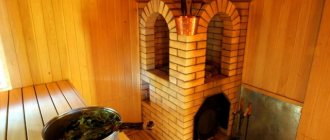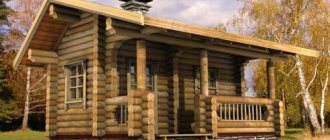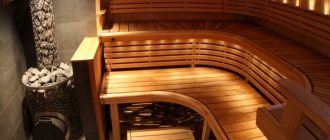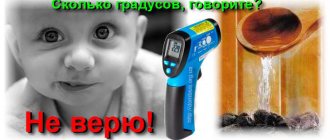The traditional type of sauna stove is a massive brick structure. This is what radical Russian bathhouse lovers think. They argue that there is simply no alternative in this matter.
However, many owners quite successfully use metal stoves, while receiving quite high-quality and comfortable bathing procedures. At the same time, they save the time required to obtain the desired temperature. In addition, there is a significant saving in space - metal stoves are much smaller than brick ones. There are other advantages and features that deserve special mention.
5/5 — (1 vote)
Advantages of metal stoves
Metal household heating stoves have an extensive list of advantages:
- Metal differs from ceramics in being much more flexible and soft, but the strength of these materials is quite comparable. The material in question is easy to melt, cut and bend, it can be drilled and forged, and the finished products do not require firing. In general, metal can be processed in a large number of ways, and this quality is clearly an advantage.
- The versatility of processing allows the creation of metal furnaces to use a lot of innovations aimed at improving the technical characteristics of the furnace. Thanks to structural changes, the efficiency of metal stoves can reach 90%, while conventional brick stoves produce about 70%.
- In the case of brick kilns, reducing the wall thickness reduces the strength of the entire structure. With metal, everything is exactly the opposite - even a very thin sheet is distinguished by its solid strength. This makes it possible to reduce the weight and cost of metal stoves several times compared to brick ones.
- Light weight and solid construction, in turn, greatly simplify the transportation of metal structures. Here it is also worth considering the strength, which gives the product excellent resistance to mechanical damage. One cannot fail to note the ease of installation - firstly, a lightweight metal stove for a home does not require a separate foundation, and secondly, its low weight allows the structure to be installed with relatively little effort.
- Another important advantage that deserves attention is the good thermal conductivity of the metal. This factor suggests that the stove’s own heat capacity is small, so the heat it generates is used only to warm up the house, which ensures high efficiency. For comparison: in brick kilns, about 20% of thermal energy is spent on heating the structure itself.
- The composition of the metal is quite homogeneous and, unlike brick, does not have a porous structure. It is also worth noting the high resistance to dampness and interruptions in heating operation. Metal wood-burning stoves do not require regular or boost kindling at all. Another advantage is the ease of installation of the hob and water heating circuit, which is facilitated by the high thermal conductivity of the material and the high rate of afterburning of gases.
- Industrially produced stoves are certified as fireproof devices, so after purchasing, all that remains is to install them. True, there are some models that require special permits for operation, but this factor does not always manifest itself.
Types of structures
They differ in structure and operating principles. Let's look at each type in more detail.
Open
The stones are laid on top of the stove structure and are not covered with anything. Due to this, the steam room warms up faster, reaching temperatures of up to 100 degrees. But the humidity in the room is low, so the heat turns out dry.
The product consists of three parts:
- fireboxes;
- compartments for stones;
- containers with water.
There should be few stones, otherwise the top layer will not warm up well and the steam room will not be warm enough.
To increase the level of humidity and the release of water vapor, the hot stones are simply watered. One or two ladles will be enough - this will give up to 15% humidity.
To increase the level of fire safety and reduce the risk of burns, it is recommended to lay fire-resistant bricks around the walls of the furnace or make a partition made of wood.
To heat a sauna, it is important that as much of the stove area as possible is in contact with the air space. This contributes to faster heating of the air in the steam room
Closed (lined with brick or stone)
If wood fuel is chosen for heating, you will have to prepare large reserves in advance. Such a stove takes a long time to reach the desired temperature, but, having reached the desired level, gives good heat transfer and retains heat for a long time.
Closed structures are great for large baths, where there is not only a steam room, a wash room, a dressing room, but also a relaxation room.
One of the advantages is closed stones. Therefore, there is no risk of getting burned.
In factory economical models, the stove has a double casing with a gap for air exchange between the walls.
Combined
For most manufacturers, the design consists of a high box with gratings and double valves (performs the function of a firebox). A chimney pipe emerges from the neck of the box. Stones are placed in the neck here.
There are devices available for sale with combined fuel types:
- gas-wood;
- electric wood-burning.
They do not need to be constantly monitored. Simply adjust to the desired temperature.
By design they are divided into 3 types:
- Monoblock. With heat exchanger, combustion chamber. Gas burner of a fixed type, covered with a steel sheet.
- Paired. They have two separate combustion chambers for wood and gas.
- Reconfigurable. Universal device. Can be modified for each fuel.
The first two types do not need to be reconfigured, since you can switch from one type of fuel to another.
Gas is used as main gas or liquefied in cylinders.
The electric-wood-burning design allows you to successfully heat the bathhouse using electricity or wood (optional). Moreover, firewood is considered the main raw material. When they burn out and the temperature drops, the electric heater automatically starts working. There are two heating elements on the sides of the product. Such stoves operate on a 220 W network, with a three-phase voltage of 380 V.
The owners can choose which fuel to heat the bathhouse with. But such designs are many times more expensive than simple wood-burning stoves.
Furnace materials
An iron stove for a home should be selected taking into account a number of factors and parameters of the design itself. The technical characteristics and design features of the stove directly affect its efficiency and reliability. One of the most important parameters is the material used to make the stove.
Different materials can be used for the production of metal furnaces:
- Steel;
- Heat-resistant steel;
- Cast iron.
As a result, structures assembled from these materials have a number of differences, so it is worth considering each type in more detail.
Steel furnaces
The most popular material for the manufacture of metal furnaces is ordinary steel. This material can easily withstand stable temperatures of up to 400 degrees, and during short-term kindling this value can reach 600 degrees. The thickness of steel usually starts from 4 mm, but one must take into account the high rate of metal burning at high temperatures - i.e. For cold regions this option is not practical.
However, there are long-burning stoves, the body of which is simply not subjected to prolonged high-temperature heating. At the same time, heat transfer is maintained at the proper level due to heat accumulators made of more durable materials. Such an iron wood-burning stove is quite suitable for heating large houses located in regions with a harsh climate.
Classification
Metal furnaces are the collective name for a broad category of devices that can be combined into separate groups according to various characteristics.
Based on body material:
steel
cast iron
Steel stoves are cheaper, they are quite efficient and practical. However, their common disadvantage is their relatively small resource - the steel burns out sooner or later. If the furnace body is made of thick sheet metal (4-5 mm), the working life can be increased. In addition, you can make a steel stove yourself.
Cast iron stoves are more expensive, but they have a long service life. At the same time, it is impossible to make a cast iron stove with your own hands.
According to the type of fuel, metal stoves are divided into:
solid fuel (firewood, coal, pallets, etc.)
gas
electric
liquid fuel
There is an opinion among experts that the best option is an electric oven. It is safe, does not require the installation of a chimney, and does not produce soot or carbon monoxide. For a sauna, this type of heating is considered the most effective. However, the cost of electricity is quite high (even too high in some regions), which makes electric ovens not very popular.
Gas furnaces are very effective, but operating gas equipment in itself is a rather dangerous undertaking. Most users prefer wood stoves - they are closest to the tradition of the Russian bath.
Expert opinion
Lovkachev Boris Petrovich
Bath master who knows everything about steaming
Liquid fuel metal stoves are not popular, as they are fueled with gasoline, diesel fuel or other similar types of fuel. For a bathhouse, this type of heating is considered not the best solution, although, with the correct placement of the stove, you can get quite successful results.
By availability of additional functions:
heater
This is a traditional element of a sauna stove, used not only to supply steam, but also as a decorative design element (this is found in electric stoves, where stones simply cover the heating elements);
possibility of remote control
This option is found only on electric and gas models, since it is impossible to regulate the supply of firewood remotely;
water tank
Not found in all models of metal stoves, it is a convenient and practical addition;
heat exchanger
It is found mainly in gas furnaces;
steam generator
A device that replaces the traditional method of supplying steam (splashing a ladle of water onto the heater). Found in models with small stone backfill.
In addition, stoves with a built-in heater differ in their design:
with open heater
At the top there is a net or basket made of metal strips filled with stones;
with closed heater
There is a compartment in the body where the stones are located. To supply water, a door is used that gives access to the stone backfill.
It is believed that an open heater produces heavier and harsher steam, typical of a Russian bath. A closed heater allows you to get softer and drier steam, more suitable for saunas.
Heat-resistant steel stoves for home
The next material from which metal furnaces can be made is heat-resistant steel. The minimum metal thickness in this case is 3 mm, which makes it possible to further reduce the weight of the structure. The efficiency of such devices often exceeds 80%, and the service life is 20 years. Metal stoves made of heat-resistant steel are safe, efficient and very easy to install - just install such a structure on the floor and connect it to the chimney.
Optionally, heat-resistant stoves are equipped with a hob and a water heater, which allows them to be used both in the country and in houses with year-round use. Unlike steel stoves, devices made of heat-resistant steel have a complex design, so such an iron stove for a summer house cannot be created with your own hands - it will be much easier to purchase and install a ready-made device.
Advantages and disadvantages
Among the advantages of steel furnaces are the following:
- high heat transfer rates, capable of heating rooms that are quite large in size;
- heat up quickly and supply heat to your home or cottage in a short time;
- safety: modern models are equipped with protective screens, so the possibility of getting a burn from an accidental touch is eliminated;
- they are compact and portable, so they can be moved from one room to another at any time;
- installation of steel furnaces is simple;
- reliable, modern samples are created from high-strength steel and cast iron;
- There is a wide variety of models on the market, made in interesting design solutions.
Metal stoves for summer cottages and wood-burning houses also have a number of disadvantages. First of all, the fuel burns out in a short time, which means that the room also cools down quickly. But the advent of long-burning stoves solved this problem. So, on one stack of firewood the unit can work for 8-10 hours.
A metal furnace is characterized by a low efficiency. But, more modern models are equipped with special heat accumulators, thanks to which the optimal temperature regime in the house is maintained.
Cast iron stoves
Another material that is suitable for creating metal stoves is cast iron. In terms of strength characteristics, cast iron is not inferior to steel, but at the same time its heat capacity and fragility are comparable to ceramics. An iron stove for a home takes longer than half an hour to warm up, but after one kindling it provides heating for the house for three hours.
The width of cast iron used for the production of stoves varies from 6 to 25 mm. If the layer of material is thicker, but the thermal expansion is too great, the oven may be damaged. Cast iron that is too thin is also not suitable - the stove will be too fragile.
The efficiency of cast iron stoves is quite high, but it can only be realized if the area of the heated house does not exceed 60 m2. In houses with a larger area, a cast iron stove simply will not be able to operate, and the temperature in the rooms will not be comfortable enough.
However, cast iron itself can easily withstand fire breaks and dampness, so such structures can be successfully used in various outbuildings that require periodic heating. Self-assembly of a cast iron stove is not possible - cast iron is very difficult to process, and such work cannot be done at home.
Chamber furnaces
A metal chamber stove is a “potbelly stove” familiar to many people, only modified to meet modern requirements for heating equipment.
The technical characteristics of such devices are as follows:
- Heat transfer is carried out mostly due to convection, and only a quarter of the generated heat comes from the body itself;
- There is no likelihood of condensation occurring, and the outlet gas temperature exceeds 100 degrees;
- The chimney must be cleaned no more than once a year;
- Efficiency reaches 60% when using coal and firewood.
You can create a metal heating stove with your own hands without much difficulty, but the process of its construction should be given a separate article.
Types of stoves by purpose and functionality
- Heating cast iron and steel stoves are designed directly for heating interior spaces. There are no additional functions;
- Heating and cooking furnaces made of steel and cast iron are a multifunctional production aimed at satisfying several requirements at once. Such stoves heat the room and have a special cooking surface. Some ovens provide an additional oven, a water circuit for producing hot water;
- Fireplace stoves are modern models of steel and cast iron fireboxes for heating and decorative purposes. In finished ovens, glass is installed in the door on the front of the body, which improves the visual effect by providing eye access to the open flame!
Channel furnaces
In channel-type furnaces, the following principle works: gases burn, cool and pass through channels between the partitions, where the process of heat transfer to the body of the device occurs. To operate such a furnace, it requires heating to 400 degrees so that the afterburning process can be activated. You can create such a metal stove for a summer residence with your own hands without any problems on the basis of a regular potbelly stove - for modification you need to leave only a horizontal section of the gas pipeline so that it separates the firebox and combustion chamber.
The oxygen necessary for combustion enters the oven through cracks in the hob or an air choke. The efficiency of channel devices can reach 80%, and their thermal power is several times higher than that of chamber devices. Channel-type stoves can operate both in normal mode and in long-burning mode, regardless of the fuel used.
The heating power varies due to the air supply, and the possibility of adjustment is an order of magnitude higher than with chamber devices. The temperature in the afterburning chamber reaches 250-300 degrees, which is quite enough for comfortable use of the hob.
Most household stoves with a power of no more than 15 kW are created using a channel design. For the manufacture of the body, 4 mm steel is most often used, and the hob is made of cast iron or steel with a thickness of 8 mm.
Main manufacturers
Let's look at the most popular manufacturers on the modern metal furnace market.
Teplodar
Teplodar - model “Vertical” (increased long-burning mode gives 8 hours of heating without adding fuel), “Stove” is equipped with a hob with removable rings, “Top Model” and “Matrix” can act as a fireplace due to fireproof glass in the doors , from where the flame is visible. The T-80 model can be equipped with a smoke exhaust.
The stoves of this manufacturer are designed to heat houses with an area of 80-300 m3, and the cost is scattered within 10-25 thousand rubles.
Ephel and Bayard
Efel is a Belgian manufacturer that leads the European home heating technology market. Thus, the “Harmony” model has a power of 12.5 kW and runs on wood and coal with a burning duration of 10 hours. That is, the oven can work all night.
The cost of such a stove is high - from 130 thousand rubles. Bayard 12 is a classic model with a hob and minimal gas emissions (0.28%). Its price is approximately 110 thousand rubles.
Eco fireplace
Another reliable company is Ecofireplace. It produces stoves that combine quality, safety and beauty. High-quality steel is used, and the facade is finished with tiles - this is aesthetically pleasing.
Thus, the Bavaria Arch model with a cast iron grate and heat-resistant glass on the doors opens up a view of the flame. This wall-mounted stove has economical fuel consumption (usually wood) and a glass self-cleaning mechanism. Such models cost about 40 thousand rubles.
The Bavaria Baroque model with a cast iron hob and a 6 mm thick fireproof steel body provides an efficiency of 78%.
Meta
produces wood-burning stoves that are maximally adapted to the Russian climate. All models have a hob with durable cast iron burners, are compact and safe.
Thus, the “Narva” series with ceramic lining and fire-resistant paint on top of a metal body is equipped with ash pans, firewood, and a glass combustion door. Its power is 6 kW and is capable of heating a house or cottage of 60 m2. Its price in the budget segment is 20 thousand rubles. "Meta Gnome-2" is the most compact model from the Meta manufacturer. Its dimensions are 363*502*640 mm and weighs 38 kg, and its power is 5 kW, which is suitable for heating a room of 50 m2.
Termofor
Finally, the Termofor company. Small-sized models for dachas and outbuildings “Selenga”, “Pichuga”, “Student”, “Avoska”, “Cinderella” are known here, which are easily portable, as well as models for heating the house - “Turbo”, “Normal”, air-heating models – “Associate Professor”, “Professor”, “Butakov”.
The latest options are very large and are permanently mounted. Prices range from 10-50 thousand rubles. Reviews about Selenga are very good: it is a beautiful oriental-style model that saves fuel well and can heat a house of 85 m2.
Bell furnaces
The last type of metal furnaces is bell furnaces. With this scheme, the gases remain under the roof of the bell until they completely burn out. Then the temperature of the burnt gas decreases, it goes down and transfers the remaining heat to the stove. This design allows you to achieve an efficiency of 70%.
This operating scheme also works well in metal heating boilers - only in this case there is no open flame, since the cap is not designed to absorb excessive amounts of heat. That is why bell furnaces operate in smoldering mode. When using firewood, the burning time reaches 60 hours, and when using coal, such structures can work for almost a month.
You can create such a metal stove for your dacha with your own hands without much effort, and the assembled structure can easily operate on both wood and coal. The only limitation is the moisture content of the fuel - it must be minimal, since it is impossible to ensure smoldering of wet fuel. Stoves originally designed only for the use of coal cannot burn wood - this point needs to be thought out in advance.
Furnaces of this type are often connected to water heating circuits, which not only provide hot water, but also enhance convection. Such stoves are actively used for heating large houses, regardless of their geographical location.
Where is the best place to install?
The choice of location for installing the furnace device must be approached thoroughly:
- It is better to place it away from external walls. This way you will retain a large amount of heat and the most optimal efficiency indicators.
- If your product is small in size and therefore weighty, it can be installed directly on the floor. If you have a rather heavy option, then it is better to make a foundation. It is not necessary to fill the perimeter with concrete; even a reinforced concrete slab can serve as the basis.
- When installing, you need to maintain a distance to the walls, which should not be less than 1 meter. This is especially true for flammable coatings.
- Next, you should take care of fire safety and call an inspector. He must approve the installation and issue the appropriate permit.











